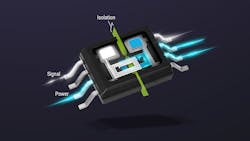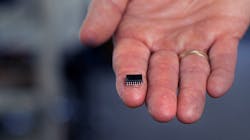High-Voltage Batteries Ahead! Proceed with Isolation!
This article is part of the Power Management Series: Delving Into Power Density
Texas Instruments introduced a family of solid-state relays that uniquely integrates power and signal transfer in a single chip with robust isolation that is becoming standard in electric vehicles (EVs).
The chips include the TPSI3050-Q1 isolated driver IC with an integrated 10-V gate supply and the TPSI2140-Q1 1,400-V isolated switch that delivers “industry-leading reliability” in a smaller envelope while reducing costs.
Jeff Morroni, head of power management R&D at TI, said car manufacturers are building batteries into EVs that have close to 10X the voltages of most vehicles on the road. As a result, they are also investing in “isolation” technologies to help keep everyone and everything inside safe from high-voltage hazards.
Danger! High-Voltage!
Electronic isolation prevents the flow of dc and excess ac between various building blocks of a high-voltage system while still allowing signals and power to flow between them. The purpose of isolation in electric vehicles is to prevent high-voltage spikes that can deliver a deadly shock or damage the electronics inside.
It is valuable when ferrying power between low- and high-side devices that must never be connected for safety purposes. Insufficient isolation also opens the door to noise and electromagnetic interference (EMI).
“Anywhere you have high voltages, safety is critical, and high voltage is critical anywhere you have to transfer power more efficiently and cost-effectively,” said Morroni, adding that in battery management and other systems in EVs, “we need to ensure the high voltages don’t make it to the chassis to prevent shock."
Today, most electric cars have internal architectures that can handle 400 V of energy from a battery pack, a step up from the 12- and 48-V systems that dominate cars today. But now, 800-V batteries are becoming standard to increase EV range and reduce charging times.
Every system in the EV is connected to the high-voltage battery pack. But the delicate electronics—such as the microcontrollers (MCUs) and other chips that control the systems in the EV—require only several volts.
TI is investing more in isolated power supplies and other automobile-grade chips such as the TPSI3050-Q1 and TPSI2140-Q1. These types of devices help electronics safely sip from the torrent of energy flowing on the main power bus and communicate with electric motors and other high-voltage, fast-transient systems.
Isolation-on-a-Chip
Designing for high reliability in high-voltage EVs typically requires the use of bulky, heavy, and thus, costly, components such as transformers and relays to control hazardous voltages and currents.
But as systems in electric cars get more compact, the components inside them must also sit closer together. That presents new design challenges for isolation, said TI's Troy Coleman, VP and GM of power switches.
TI is trying to transform the heavy coils of wiring winding in transformers and the tightly wound cylindrical coils and mechanical switches of relays into components that can fit inside a standard IC package while maintaining safety.
TI rolled out in 2020 a proprietary integrated transformer technology that brings high-density, isolated dc-dc power conversion into a single package, replacing transformers—one of the stalwarts in the world of isolation, used for safety purposes and to keep transients and harmonics in check. To help reduce costs in electric vehicles, TI is integrating the technology into more of its high-reliability automotive power supplies.
The solid-state relays are the latest in TI’s growing portfolio of ICs for isolating signals and power in cars. The company said they are the first in a solid-state relay family that will include industrial-grade devices.
Protecting against high-voltage spikes is vital in industrial-grade power supplies, such as solar and other renewable-powered grid inverters, in addition to robotics and motor control systems. Eliminating disruptive ground loops in power rails with large ground-potential differences (GPDs) is important. Preserving data during common-mode transients and keeping high-side devices safely isolated also are priorities.
Reinforced Isolation
The TPSI3050-Q1 is TI’s automotive-grade switch driver with reinforced isolation that can be paired with a single dc power switch or dual back-to-back ac power switches to create a complete solid-state relay. TI said the chip integrates power and signal transfer across a single “isolation barrier” that separates the low- from the high-voltage side (the battery side) of the power rail to better protect against high-voltage spikes.
The integrated 10-V gate supply voltage means there is no need for an isolated secondary supply bias. The TPSI3050-Q1 can also serve as an isolated dc-dc power supply that delivers 50 mW to auxiliary ICs.
TI said the highlights of the TPSI3050-Q1 are robustness and reliability. The reinforced isolation offers up to 5 kVRMS of protection. According to TI, the switch driver, which can handle a harsh temperature range of –40 to 125°C, has a 10X longer lifespan in a smaller package than electromechanical relays, which can break down through constant use. The chip fits inside a 7.50- × 5.85-mm SOIC package.
For safety purposes, many industry standards require parts with “basic” isolation, which according to TI offers a single layer of isolation against shock and other hazards in cars. But that means if the isolation barrier is breached, any additional protection is gone. For “reinforced” isolation, the components must be able to prove electrical strength, reliability, and shock protection equal to twice the basic isolation rating.
The high level of integration in the chip displaces at least three components, reducing the footprint up to 90% by integrating the functions of an isolated power supply, digital isolator, and gate driver in a single chip.
The new solid-state relays can disconnect and connect loads through a single isolation barrier in a fraction of the time of electromechanical relays, allowing for safer operation of high-voltage automotive systems.
With an integrated gate-drive voltage of 10-V with 1.5/3.0-A peak source and sink current, TI said that its customers can pair it with a wide range of external power switches in systems such as onboard chargers.
50% Off Isolation
The TPSI2140-Q1 is a 1400-V, 50-mA isolated switch that also integrates power and signal transmission in a single chip, saving up to 50% of space compared to other non-mechanical devices called photorelays.
Basic isolation protection is 3.75 kVRMS, giving it 4X greater durability against dielectric breakdown than alternatives. The chip tolerates up to 2 mA of avalanche current—3X more than existing solutions to bolster safety and slow down degradation. TI also offers the TPSI2140T-Q1, equipped with its Thermal Avalanche Protection (TAP) feature, which can contain avalanche currents up to 5 mA, adding further robustness.
TI said the component, housed in a 10.3- × 7.5-mm SOIC package with wide pins for improved thermal dissipation, runs on a primary side supply current of 7.5 mA in the “on” state and 6 μA in the “off” state.
TI is bringing a wide range of other protection features into the fold with the TPSI2140-Q1, which uses the company’s capacitive isolation technology to protect against high-voltage spikes in electric cars. The semiconductor giant said the switch withstands a peak voltage surge—also called VIOSM—of up to 6,000 V. Furthermore, it has an estimated useful lifespan of more than 25 years under high voltages of 1,000 VRMS.
TI said that it is ideal for battery-management systems at the heart of EVs to detect faults in the insulation enveloping high-voltage batteries faster and with higher reliability than optoelectronics-based photorelays.
The TPSI3050- and TPSI2140-Q1 are in pre-production. Pricing is $1.99 and $2.75, respectively, in 1,000-unit quantities.
Read more articles in the Power Management Series: Delving Into Power Density
About the Author
James Morra
Senior Editor
James Morra is the senior editor for Electronic Design, covering the semiconductor industry and new technology trends, with a focus on power electronics and power management. He also reports on the business behind electrical engineering, including the electronics supply chain. He joined Electronic Design in 2015 and is based in Chicago, Illinois.



